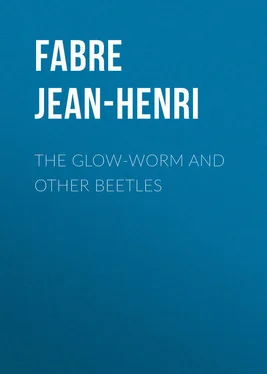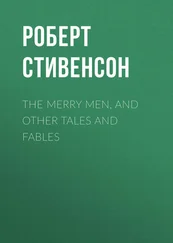Jean-Henri Fabre - The Glow-Worm and Other Beetles
Здесь есть возможность читать онлайн «Jean-Henri Fabre - The Glow-Worm and Other Beetles» — ознакомительный отрывок электронной книги совершенно бесплатно, а после прочтения отрывка купить полную версию. В некоторых случаях можно слушать аудио, скачать через торрент в формате fb2 и присутствует краткое содержание. Жанр: foreign_antique, foreign_prose, на английском языке. Описание произведения, (предисловие) а так же отзывы посетителей доступны на портале библиотеки ЛибКат.
- Название:The Glow-Worm and Other Beetles
- Автор:
- Жанр:
- Год:неизвестен
- ISBN:нет данных
- Рейтинг книги:5 / 5. Голосов: 1
-
Избранное:Добавить в избранное
- Отзывы:
-
Ваша оценка:
- 100
- 1
- 2
- 3
- 4
- 5
The Glow-Worm and Other Beetles: краткое содержание, описание и аннотация
Предлагаем к чтению аннотацию, описание, краткое содержание или предисловие (зависит от того, что написал сам автор книги «The Glow-Worm and Other Beetles»). Если вы не нашли необходимую информацию о книге — напишите в комментариях, мы постараемся отыскать её.
The Glow-Worm and Other Beetles — читать онлайн ознакомительный отрывок
Ниже представлен текст книги, разбитый по страницам. Система сохранения места последней прочитанной страницы, позволяет с удобством читать онлайн бесплатно книгу «The Glow-Worm and Other Beetles», без необходимости каждый раз заново искать на чём Вы остановились. Поставьте закладку, и сможете в любой момент перейти на страницу, на которой закончили чтение.
Интервал:
Закладка:
Here is the proof of the sudden efficacity of those twitches, so mild in appearance: I take the Snail from the Lampyris, who has operated on the edge of the mantle some four or five times. I prick him with a fine needle in the fore-part, which the animal, shrunk into its shell, still leaves exposed. There is no quiver of the wounded tissues, no reaction against the brutality of the needle. A corpse itself could not give fewer signs of life.
Here is something even more conclusive: chance occasionally gives me Snails attacked by the Lampyris while they are creeping along, the foot slowly crawling, the tentacles swollen to their full extent. A few disordered movements betray a brief excitement on the part of the mollusc and then everything ceases: the foot no longer slugs; the front-part loses its graceful swan-neck curve; the tentacles become limp and give way under their weight, dangling feebly like a broken stick. This conditions persists.
Is the Snail really dead? Not at all, for I am free to resuscitate the seeming corpse. After two or three days of that singular condition which is no longer life and yet not death, I isolate the patient and, although this is not really necessary to success, I give him a douche which will represent the shower so dear to the able-bodied mollusc. In about a couple of days, my prisoner, but lately injured by the Glow-worm's treachery, is restored to his normal state. He revives, in a manner; he recovers movement and sensibility. He is affected by the stimulus of a needle; he shifts his place, crawls, puts out his tentacles, as though nothing unusual had occurred. The general torpor, a sort of deep drunkenness, has vanished outright. The dead returns to life. What name shall we give to that form of existence which, for a time, abolishes the power of movement and the sense of pain? I can see but one that is approximately suitable: anæsthesia. The exploits of a host of Wasps whose flesh-eating grubs are provided with meat that is motionless though not dead 2 2 Cf. The Hunting Wasps , by J. Henri Fabre, translated by Alexander Teixeira de Mattos: passim . — Translator's Note .
have taught us the skilful art of the paralyzing insect, which numbs the locomotory nerve-centres with its venom. We have now a humble little animal that first produces complete anæsthesia in its patient. Human science did not in reality invent this art, which is one of the wonders of our latter-day surgery. Much earlier, far back in the centuries, the Lampyris and, apparently, others knew it as well. The animal's knowledge had a long start of ours; the method alone has changed. Our operators proceed by making us inhale the fumes of ether or chloroform; the insect proceeds by injecting a special virus that comes from the mandibular fangs in infinitesimal doses. Might we not one day be able to benefit by this hint? What glorious discoveries the future would have in store for us, if we understood the beastie's secrets better!
What does the Lampyris want with anæsthetical talent against a harmless and moreover eminently peaceful adversary, who would never begin the quarrel of his own accord? I think I see. We find in Algeria a Beetle known as Drilus maroccanus , who, though non-luminous, approaches our Glow-worm in his organization and especially in his habits. He too feeds on land molluscs. His prey is a Cyclostome with a graceful spiral shell, tight-closed with a stony lid which is attached to the animal by a powerful muscle. The lid is a movable door which is quickly shut by the inmate's mere withdrawal into his house and as easily opened when the hermit goes forth. With this system of closing, the abode becomes inviolable; and the Drilus knows it.
Fixed to the surface of the shell by an adhesive apparatus whereof the Lampyris will presently show us the equivalent, he remains on the look-out, waiting, if necessary, for whole days at a time. At last, the need of air and food oblige the besieged noncombatant to show himself; at least, the door is set slightly ajar. That is enough. The Drilus is on the spot and strikes his blow. The door can no longer be closed and the assailant is henceforth master of the fortress. Our first impression is that the muscle moving the lid has been cut with a quick-acting pair of shears. This idea must be dismissed. The Drilus is not well enough equipped with jaws to gnaw through a fleshy mass so promptly. The operation has to succeed at once, at the first touch: if not, the animal attacked would retreat, still in full vigour, and the siege must be recommenced, as arduous as ever, exposing the insect to fasts indefinitely prolonged. Although I have never come across the Drilus, who is a stranger to my district, I conjecture a method of attack very similar to that of the Glow-worm. Like our own Snail-eater, the Algerian insect does not cut its victim into small pieces: it renders it inert, chloroforms it by means of a few tweaks which are easily distributed, if the lid but half-opens for a second. That will do. The besieger thereupon enters and, in perfect quiet, consumes a prey incapable of the least muscular effort. That is how I see things by the unaided light of logic.
Let us now return to the Glow-worm. When the Snail is on the ground, creeping, or even shrunk into his shell, the attack never presents any difficulty. The shell possesses no lid and leaves the hermit's fore-part to a great extent exposed. Here, on the edges of the mantle contracted by the fear of danger, the mollusc is vulnerable and incapable of defence. But it also frequently happens that the Snail occupies a raised position, clinging to the tip of a grass-stalk or perhaps to the smooth surface of a stone. This support serves him as a temporary lid; it wards off the aggression of any churl who might try to molest the inhabitant of the cabin, always on the express condition that no slit show itself anywhere on the protecting circumference. If, on the other hand, in the frequent case when the shell does not fit its support quite closely, some point, however tiny, be left uncovered, this is enough for the subtle tools of the Lampyris, who just nibbles at the mollusc and at once plunges him into that profound immobility which favours the tranquil proceedings of the consumer.
These proceedings are marked by extreme prudence. The assailant has to handle his victim gingerly, without provoking contractions which would make the Snail let go his support and, at the very least, precipitate him from the tall stalk whereon he is blissfully slumbering. Now any game falling to the ground would seem to be so much sheer loss, for the Glow-worm has no great zeal for hunting-expeditions: he profits by the discoveries which good luck sends him, without undertaking assiduous searches. It is essential, therefore, that the equilibrium of a prize perched on the top of a stalk and only just held in position by a touch of glue should be disturbed as little as possible during the onslaught; it is necessary that the assailant should go to work with infinite circumspection and without producing pain, lest any muscular reaction should provoke a fall and endanger the prize. As we see, sudden and profound anæsthesia is an excellent means of enabling the Lampyris to attain his object, which is to consume his prey in perfect quiet.
What is his manner of consuming it? Does he really eat, that is to say, does he divide his food piecemeal, does he carve it into minute particles, which are afterwards ground by a chewing-apparatus? I think not. I never see a trace of solid nourishment on my captives' mouths. The Glow-worm does not eat in the strict sense of the word: he drinks his fill; he feeds on a thin gruel into which he transforms his prey by a method recalling that of the maggot. Like the flesh-eating grub of the Fly, he too is able to digest before consuming; he liquefies his prey before feeding on it.
Читать дальшеИнтервал:
Закладка:
Похожие книги на «The Glow-Worm and Other Beetles»
Представляем Вашему вниманию похожие книги на «The Glow-Worm and Other Beetles» списком для выбора. Мы отобрали схожую по названию и смыслу литературу в надежде предоставить читателям больше вариантов отыскать новые, интересные, ещё непрочитанные произведения.
Обсуждение, отзывы о книге «The Glow-Worm and Other Beetles» и просто собственные мнения читателей. Оставьте ваши комментарии, напишите, что Вы думаете о произведении, его смысле или главных героях. Укажите что конкретно понравилось, а что нет, и почему Вы так считаете.












